Chiricahuas and Willcox
Wednesday August 1st, 2012: We started the day by birding along Stateline Road. Since we were headed south, birds to the right of the road (west) count for Arizona, birds to the left (east) count for New Mexico. It wasn't long before we spotted a pale meadowlark, Lilian's Meadowlark. A little farther down a Lark Bunting flew across the road (counts for two states). We lost radio communication along here due to low batteries. We found out later that the other van saw Scaled Quail here. We also encountered Desert Cottontail and Black-tailed Jackrabbit.
When we reached the highway, we headed up to Rodeo hoping for Bendire's Thrasher. Usually, I've seen a lot of thrashers in Rodeo, both Bendire's and Curve-billed. This time we only saw a few Curve-billed Thrashers and no Bendire's. We did find a lot of Eurasian Collared-Doves and quail. Most of the quail were Gambel's Quail, but a few Scaled Quail were present too. I found a hybrid quail in the group too. An odd-looking bunting near Rodeo was evidently a Lazuli Bunting that was devoid of any rufous coloration. That was a catch-up bird for me.
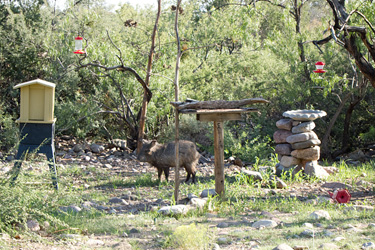 |
| Javelina at the Feeders |
|---|
We drove back toward Rodeo, but detoured on Foothills road to the Big Thicket This used to be Dave Jasper's house, and the new owner has continued Dave's tradition of great bird feeders that are open to the public. Unfortunately, we were confused about visiting hours, and didn't realize they opened at 6:30. As a result, we arrived at 7:30. At least 4 Javelinas (Collared Pecaries) were occupying the feeders when we arrived. They left, and we got settled in. As we were doing this, birds started to return. Lucy's Warbler was the only new bird, but we got great looks at some of the other desert birds. We were disappointed that no Crissal Thrashers visited while we were there.
By now it was time for breakfast, and we returned to the Portal Peak Lodge. After breakfast, we packed up the vans and headed out the paradise road. We stopped again at the bridge. This time we heard Black-chinned Sparrow, but extensive searching, including climbing up on the ridge, failed to produce a sighting.
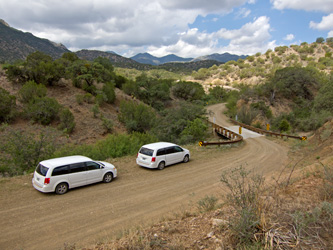 |
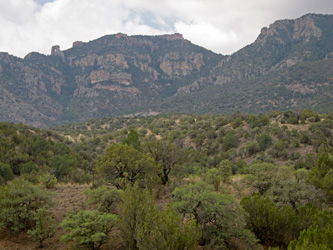 |
We continued up toward the road intersection at East Turkey Creek hoping for Montezuma Quail, but none were found. This would be a lifer not only for the group, but for my co-leader, Brian. I'm the only one of us who has seen the beast before. We turned down the road back to Portal, and continued our search. Right after we turned toward Herb Martyr campground, David spotted two Montezuma Quail crossing a path on the Southwest Research Station property across from the main SWRS complex. Everyone in my van saw them as I radioed to Brian that we had the quail. Although it only took a minute for him to arrive, and I think some of his van saw them, the quail hunkered down before he look.
We all got out to try to spot them, without success. I walked toward where they had been, thinking they had slunk off to the left. I only gave a cursory look to the ground ahead of me as I though they were no longer there — big mistake! The quail exploded out right in front of me and flew up the slope in two directions. By now, I think most of the group had seen them, but Brian still hadn't had a good look. We fanned out over the slope in search of the quail. Eventually, someone spotted one, and saw the other fly in to join it. This time, the quail were more skittish and flew off before we could get Brian over to see them. Fortunately, one of them headed straight for Brian, and he finally got his quail.
After a return visit to the SWRS gift shop, we headed back up to East Turkey Creek, then over Onion Saddle into Pinery Canyon. The forest here had been severely burned by the Horseshoe 2 fire last year. Wildflowers were especially evident here due to the burn. We stopped for a couple of what we hoped were goshawks, but turned out to be Cooper's Hawks. We got a surprise as we approached the highway near Chiricahua National Monument. A young Brown Pelican was sitting in a field. It had probably been blown in by one of the recent storms. Obviously, it's chances of survival were poor. We stopped in at Chiricahua Monument to try to get it some help. The ranger at the visitor's center put in a lot of effort to try to get it to a rehabber. She was still working on it when we left, and we don't know if she was successful.
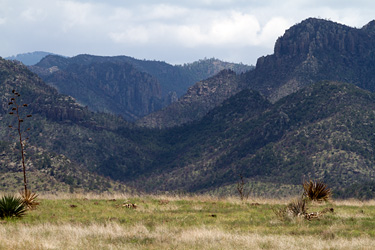 |
| Pinery Canyon |
|---|
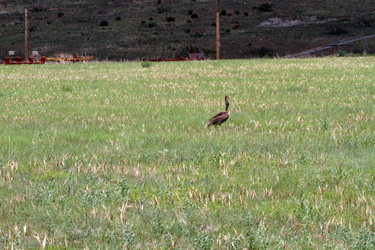 |
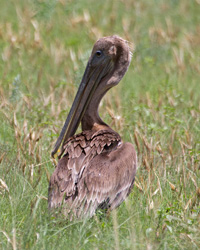 |
| Brown Pelican | |
|---|---|
After lunch at the monument, we continued on toward Willcox and Lake Cochise where we hoped to see a number of shorebirds. We noticed a Spotted Sandpiper in a small pond near the golf course. When we arrived at the lake, we immediately noticed the Wilson's Phalaropes. David put some effort into estimating their numbers, about 650. I put a lot of effort into an unsuccessful attempt to find the reported Red-necked Phalarope. It was quite amazing (and dizzying) to watch masses of spinning phalaropes in the scope.
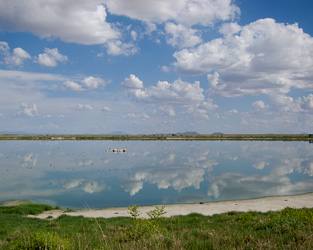 |
| Lake Cochise |
|---|
Numerous other shorebirds were present. We found Western Sandpiper, Semipalmated Sandpiper, and Lesser Yellowlegs right along the shore at our first stop. I also heard a Greater Yellowlegs calling, but never found it. The scopes revealed a number of Baird's Sandpipers. Scopes weren't really needed to see the Black-necked Stilts and American Avocets. There was a Least Sandpiper a little further away, and a Red Knot on the other side. As we moved around the lake, we also added Ruddy Duck, Cinnamon Teal, Black Tern, Long-billed Dowitcher, and Stilt Sandpiper. The shorebirds were put up a couple of times, by a Peregrine Falcon and by a Swainson's Hawk. A male Northern Harrier took off from one of the smaller ponds as we drove around Lake Cochise.
Once we finished at Lake Cochise, we headed back to Tucson. Our trip is almost done…almost.
We encountered 70 species today. Of them, 24 were new for the trip (25 for me). Our trip total is now 162 species and mine is 161. We saw 3 new mammals, and the trip total is 12.
Comfort Suites Airport, Tucson, AZ